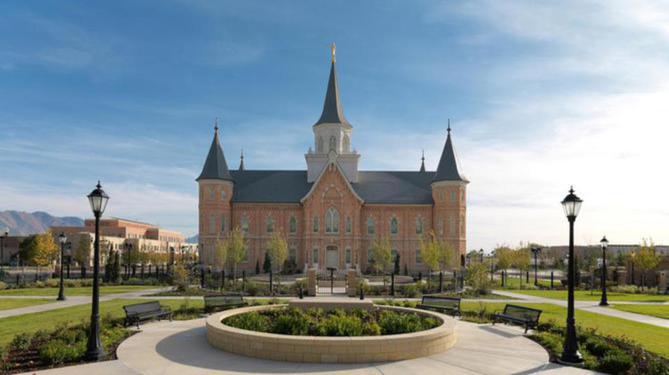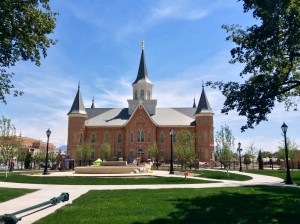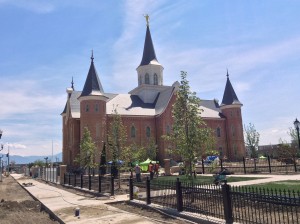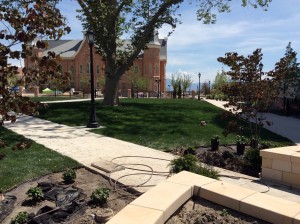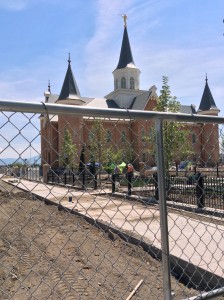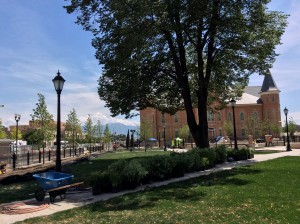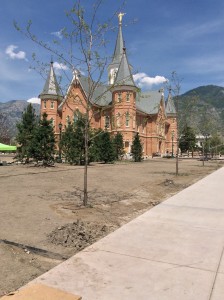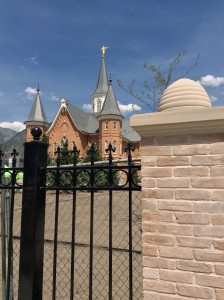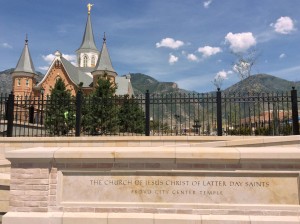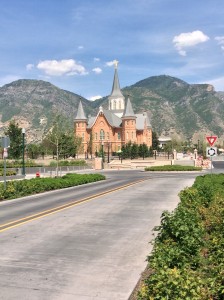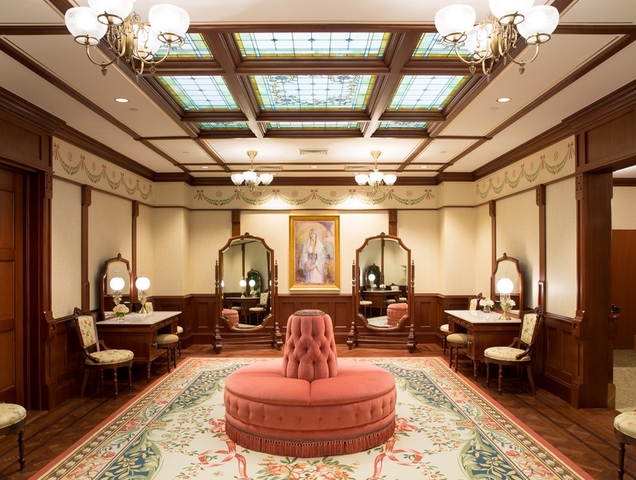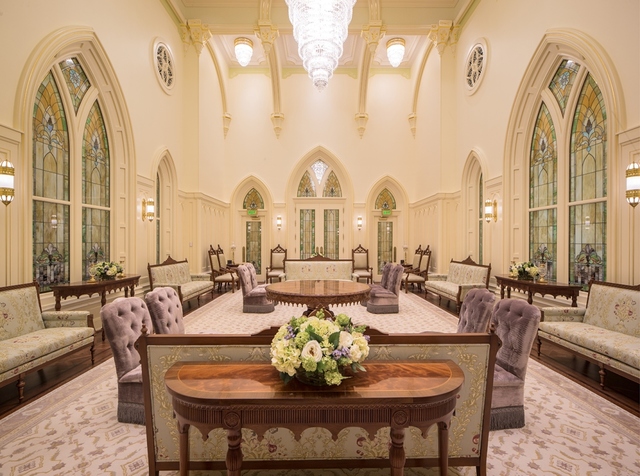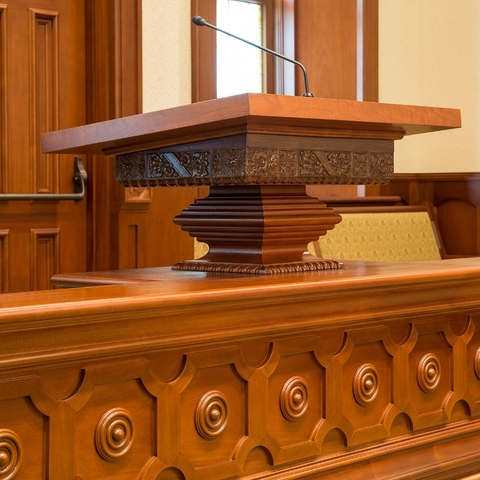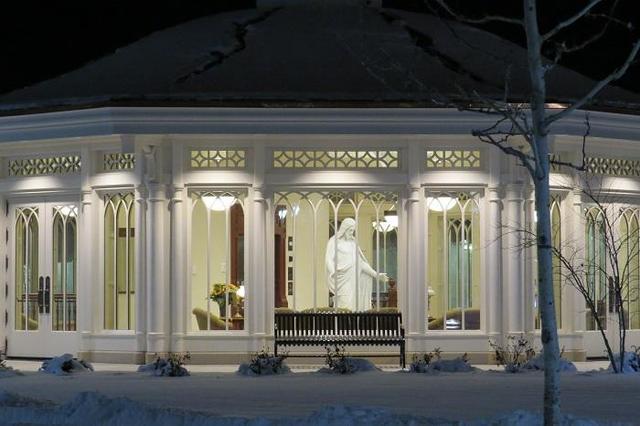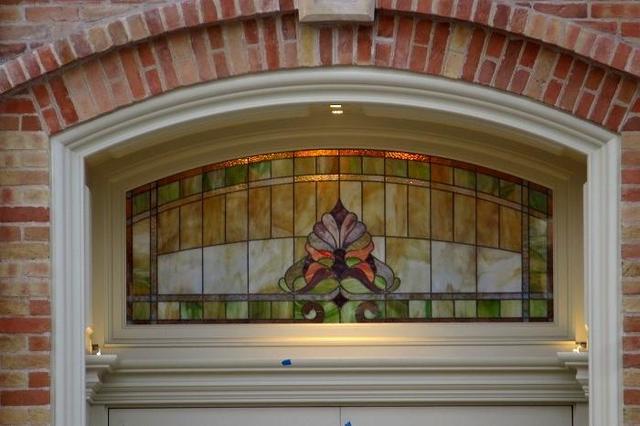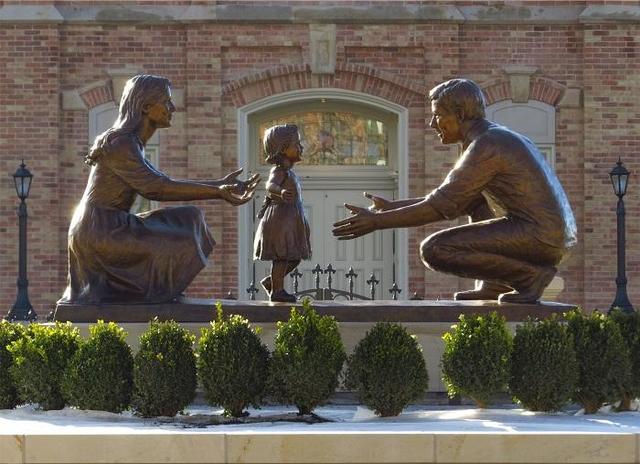Difference between revisions of "Provo City Center Temple"
m |
m |
||
| (14 intermediate revisions by the same user not shown) | |||
| Line 1: | Line 1: | ||
| − | [[Image:provo-city-center | + | [[Image:provo-city-center-temple.jpg|alt=Provo City Center Temple|right|frame|The north side of the Provo City Center Temple. (Mormon Newsroom)]] |
| − | When a fire tragically gutted the iconic Provo Utah Tabernacle in December 2010, questions immediately arose about what to do with the remains and grounds of the building, which had been a city landmark for more than 100 years. The beautiful structure, built between 1883 and 1898, was venerated by Provo residents and generations of [[Brigham Young University]] students who used it for church meetings and concerts. | + | When a fire tragically gutted the iconic Provo Utah Tabernacle in the early morning of [http://www.mormonnewsroom.org/article/fire-damages-historic-provo-tabernacle 17 December 2010], questions immediately arose about what to do with the remains and grounds of the building, which had been a city landmark for more than 100 years. The beautiful structure, built between 1883 and 1898, was venerated by Provo residents and generations of [[Brigham Young University]] students who used it for church meetings and concerts. |
The early Saints built the Provo Utah Tabernacle to be used as a meeting place. The edifice was dedicated in April 1898 by [[George Q. Cannon]], then serving as a member of the Church's [[First Presidency]]. Over 4,000 people were in attendance, both inside and outside the building. President Cannon was accompanied by [[Joseph F. Smith]], [[John Henry Smith]], [[Heber J. Grant]], [[Reed Smoot]] and local leader [[Karl G. Maeser|Dr. Karl G. Maeser]]. The building was used not only to host a few sessions of [[General Conference]] (in 1886 and 1887), but also became a venue for over a century of concerts, conferences, graduation ceremonies, and funerals. [http://www.deseretnews.com/article/705331478/Taft-left-a-big-impression-on-Utahns-in-1909.html?pg=all U.S. President, William H. Taft], visited Utah on 24 - 26 September 1909 and gave an address in the Tabernacle prior to going to Salt Lake City, and Sergei Rachmaninoff filled its hall with his music in 1938. | The early Saints built the Provo Utah Tabernacle to be used as a meeting place. The edifice was dedicated in April 1898 by [[George Q. Cannon]], then serving as a member of the Church's [[First Presidency]]. Over 4,000 people were in attendance, both inside and outside the building. President Cannon was accompanied by [[Joseph F. Smith]], [[John Henry Smith]], [[Heber J. Grant]], [[Reed Smoot]] and local leader [[Karl G. Maeser|Dr. Karl G. Maeser]]. The building was used not only to host a few sessions of [[General Conference]] (in 1886 and 1887), but also became a venue for over a century of concerts, conferences, graduation ceremonies, and funerals. [http://www.deseretnews.com/article/705331478/Taft-left-a-big-impression-on-Utahns-in-1909.html?pg=all U.S. President, William H. Taft], visited Utah on 24 - 26 September 1909 and gave an address in the Tabernacle prior to going to Salt Lake City, and Sergei Rachmaninoff filled its hall with his music in 1938. | ||
| Line 47: | Line 47: | ||
Following a five-year restoration of the former Provo Tabernacle, the Provo City Center Temple is now complete. The more than a century-old icon (Provo Tabernacle) located in the central Utah community of Provo which will now serve as a House of the Lord, will open its doors to allow the general public to have a look inside beginning on Friday, 15 January 2016. The temple will be dedicated on Sunday, 20 March 2016. Once the temple is dedicated, only [[Temple Recommend|temple worthy]] members of [[The Church of Jesus Christ of Latter-day Saints]] will be able to attend to perform sacred ordinances. For more information about the restoration project, please visit the [http://www.mormonnewsroom.org/article/provo-city-center-temple-public-tours Mormon Newsroom]. | Following a five-year restoration of the former Provo Tabernacle, the Provo City Center Temple is now complete. The more than a century-old icon (Provo Tabernacle) located in the central Utah community of Provo which will now serve as a House of the Lord, will open its doors to allow the general public to have a look inside beginning on Friday, 15 January 2016. The temple will be dedicated on Sunday, 20 March 2016. Once the temple is dedicated, only [[Temple Recommend|temple worthy]] members of [[The Church of Jesus Christ of Latter-day Saints]] will be able to attend to perform sacred ordinances. For more information about the restoration project, please visit the [http://www.mormonnewsroom.org/article/provo-city-center-temple-public-tours Mormon Newsroom]. | ||
| − | < | + | <embedvideo service="youtube" urlargs="rel=0" dimensions="400" alignment="inline">https://youtube.com/watch?v=MVoZ_5kGhqc&rel=0</embedvideo> |
| − | < | + | <embedvideo service="youtube" urlargs="rel=0" dimensions="400" alignment="inline">https://youtube.com/watch?v=1lZh7ecOSlg&rel=0</embedvideo> |
==Open House Announced for Provo City Center Temple== | ==Open House Announced for Provo City Center Temple== | ||
| Line 80: | Line 80: | ||
</gallery> | </gallery> | ||
| − | ==Cultural Celebration | + | ==Cultural Celebration== |
| − | On Saturday, 19 March 2016, a | + | On Saturday evening, 19 March 2016, four and a half years after President [[Thomas S. Monson]] announced plans for the Provo City Center Temple, approximately 4,500 youth joined together to celebrate the completion of the 150th temple for The Church of Jesus Christ of Latter-day Saints, and to commemorate the heritage of the Provo region through narration, song, and dance. |
| − | The | + | The cultural celebration took place at the Marriott Center in Provo, Utah. Before the celebration began, Elder [[Dallin H. Oaks]] of the [[Quorum of the Twelve Apostles]] addressed the youth from the Provo and Springville area stakes. Many other LDS Church leaders attended the event, including youth general auxiliary leaders. The theme of the celebration was "Beauty for Ashes" (see [https://www.lds.org/scriptures/ot/isa/61.3?lang=eng#2 Isaiah 61:3]) which represented the old Provo Tabernacle that was gutted by fire in 2010 being transformed into a beautiful sacred edifice. |
| − | + | Director of the cultural celebration, [http://www.deseretnews.com/article/865650504/Provo-City-Center-Temple-youth-cultural-celebration-Beauty-for-Ashes.html?s_cid=Email-4 Polly K. Dunn, commented], "These youth are just wonderful. I think the very act of pulling [the youth] together and doing this celebration helps them to focus on the dedication of this temple." The event included photos, short videos and dances highlighting the history of the Provo Tabernacle. Dunn further remarked, "The very first thoughts when I was called, before I even had a committee, … were, this building had an incredible life. This building that was built by pioneers without electricity, without power tools, without even running water, it just had such an incredible life. I just felt from the get-go that the program needed to revolve around this building." Based mostly on stories from the community and people who have had experiences in the old Provo Tabernacle, the cultural celebration walked the audience through a timeline of events, sharing the important role the building has played in the community over the years, beginning with the sacrifice and dedication of early Church members young and old. Dubbed as a “place where givers give,” the building had been used as gathering place for Church or civic meetings, service opportunities and cultural events. Over the years many special guests such as President William H. Taft, renowned musician John Phillip Sousa, Helen Keller, and poet Robert Frost visited the Provo Tabernacle. | |
| + | |||
| + | One of the participants, 17-year-old Zack Sink, who remembers seeing the smoke from the temple as he was sitting on a bus on the way to school, commented, "It is a beacon of hope to me in my life." And Isai Sanchez, 14, commented that all of the hard work, practices and even learning to dance has been a good experience “because it is for something special. And I can tell future generations I danced for that temple." | ||
| + | |||
| + | <embedvideo service="youtube" urlargs="rel=0" dimensions="400" alignment="inline">https://youtube.com/watch?v=1h6NPMglZaI&rel=0</embedvideo> | ||
| + | |||
| + | <embedvideo service="youtube" urlargs="rel=0" dimensions="400" alignment="inline">https://youtube.com/watch?v=raZ4P22wzgg&rel=0</embedvideo> | ||
| + | |||
| + | <embedvideo service="youtube" urlargs="rel=0" dimensions="400" alignment="inline">https://youtube.com/watch?v=ifBc7uI3iUE&rel=0</embedvideo> | ||
| + | |||
| + | ==Temple Dedication== | ||
| + | |||
| + | The Provo City Center Temple was dedicated in three sessions on Sunday, 20 March 2016 by Elder [[Dallin H. Oaks]] of the [[Quorum of the Twelve Apostles]]. The dedication took place on the 115th anniversary of the death of [http://www.findagrave.com/cgi-bin/fg.cgi?page=gr&GRid=24642181 William Harrison Folsom], the original architect of the Provo Tabernacle. The dedicatory sessions were held at 9:00 a.m., 12:00 p.m. and 3:00 p.m. MDT, and broadcast to Utah meetinghouses. The normal three-hour block of meetings were cancelled to allow members to participate in the sacred events. Tickets, distributed through local church leaders, were required to view the broadcast. A cornerstone ceremony, with music provided by the Mormon Tabernacle Choir, took place at the southeast corner of the temple at the start of the first dedicatory session. Elder Oaks and Elders [[Lynn G. Robbins]] of the [[Presidency of the Seventy]], Elder Richards and the new temple presidency, helped secure the cornerstone with mortar, the symbolic completion of the temple. Elder Oaks also invited a young woman and young man to place mortar around the cornerstone to represent, what he called, “The rising generation that will come to the temple in the future.” | ||
| + | |||
| + | On Tuesday, 22 March 2016, the doors of the temple will open for members of the Church who have valid temple recommends to perform temple [[ordinances]], including [[Marriage|marriages]] and [[Baptism for the Dead|baptisms for the dead]]. The temple will serve Latter-day Saints living in 29 LDS stakes in Provo and Springville, including university student and single-adult stakes. | ||
Mariah Proctor in her Meridian Magazine article titled "[http://ldsmag.com/provo-city-center-temple-a-mighty-change-at-the-heart/ Provo City Center Temple: A Mighty Change at the Heart]" published on 12 November 2015 noted: | Mariah Proctor in her Meridian Magazine article titled "[http://ldsmag.com/provo-city-center-temple-a-mighty-change-at-the-heart/ Provo City Center Temple: A Mighty Change at the Heart]" published on 12 November 2015 noted: | ||
| Line 94: | Line 108: | ||
:One of the most striking parts of the whole history and now conversion of the Provo Tabernacle into the Provo City Center Temple is all of the stories. The structure has already been a part of thousands of lives. From those that walked door to door collecting funds for the original building to the owner of a single shoe left there in the 19th century and found in the excavations, those that met their spouses at events there, heard speakers that changed their testimonies forever or sat in their graduation ceremonies in those seats, nervous about what to do next. And that’s before the hundreds of people that have worked to convert the building into a temple even came on the scene. | :One of the most striking parts of the whole history and now conversion of the Provo Tabernacle into the Provo City Center Temple is all of the stories. The structure has already been a part of thousands of lives. From those that walked door to door collecting funds for the original building to the owner of a single shoe left there in the 19th century and found in the excavations, those that met their spouses at events there, heard speakers that changed their testimonies forever or sat in their graduation ceremonies in those seats, nervous about what to do next. And that’s before the hundreds of people that have worked to convert the building into a temple even came on the scene. | ||
| − | < | + | Other temples in Utah include the [[Salt Lake Temple]], [[Brigham City Utah Temple]], [[Logan Utah Temple]], [[Ogden Utah Temple]], [[Bountiful Utah Temple]], [[Jordan River Utah Temple]], [[Draper Utah Temple]], [[Oquirrh Mountain Utah Temple]], [[Vernal Utah Temple]], [[Mount Timpanogos Utah Temple]], [[Provo Utah Temple]], [[Payson Utah Temple]], [[Manti Utah Temple]], [[St. George Utah Temple]], and [[Monticello Utah Temple]]. Under construction is the [[Cedar City Utah Temple]] in southern Utah. |
| + | |||
| + | <embedvideo service="youtube" urlargs="rel=0" dimensions="400" alignment="inline">https://youtube.com/watch?v=rJFHrx3p8BI&rel=0</embedvideo> | ||
| − | < | + | <embedvideo service="youtube" urlargs="rel=0" dimensions="400" alignment="inline">https://youtube.com/watch?v=_ag2Yrx_uPc&rel=0</embedvideo> |
| − | < | + | <embedvideo service="youtube" urlargs="rel=0" dimensions="400" alignment="inline">https://youtube.com/watch?v=bGLBo02IvSM&rel=0</embedvideo> |
| − | < | + | <embedvideo service="youtube" urlargs="rel=0" dimensions="400" alignment="inline">https://youtube.com/watch?v=lXLEODwYTGk&rel=0</embedvideo> |
==External links== | ==External links== | ||
Revision as of 19:31, 26 August 2016
When a fire tragically gutted the iconic Provo Utah Tabernacle in the early morning of 17 December 2010, questions immediately arose about what to do with the remains and grounds of the building, which had been a city landmark for more than 100 years. The beautiful structure, built between 1883 and 1898, was venerated by Provo residents and generations of Brigham Young University students who used it for church meetings and concerts.
The early Saints built the Provo Utah Tabernacle to be used as a meeting place. The edifice was dedicated in April 1898 by George Q. Cannon, then serving as a member of the Church's First Presidency. Over 4,000 people were in attendance, both inside and outside the building. President Cannon was accompanied by Joseph F. Smith, John Henry Smith, Heber J. Grant, Reed Smoot and local leader Dr. Karl G. Maeser. The building was used not only to host a few sessions of General Conference (in 1886 and 1887), but also became a venue for over a century of concerts, conferences, graduation ceremonies, and funerals. U.S. President, William H. Taft, visited Utah on 24 - 26 September 1909 and gave an address in the Tabernacle prior to going to Salt Lake City, and Sergei Rachmaninoff filled its hall with his music in 1938.
On 1 October 2011 at the LDS Church’s 181st semi-annual general conference, Prophet Thomas S. Monson announced that the historic building would be remade into a temple. An audible gasp of joy filled the Conference Center.
Patterned after a similar situation with the 1997 dedication of the Vernal Utah Temple, which was built from the Uintah Stake Tabernacle of the early 1900s, this second Provo temple will include a complete restoration of the original exterior design of the Provo Tabernacle.
In recent months, the Church has acquired properties adjacent to the tabernacle. In August 2011, it announced the purchasing of land from two nearby businesses (Travelodge Motel and Los 3 Amigos restaurant). The following month, the Provo Municipal Council passed a vote to sell the Church the land on which the Hotel Roberts stood before it was demolished in 2004. The Church will own the entire block on which the tabernacle stands, with the exception of the property belonging to the U.S. Post Office, and has indicated no plans to pursue ownership of that portion of land.
The original Provo Utah Temple is currently the most-used temple in the world. The nearby Missionary Training Center and campus of Brigham Young University supply the temple with thousands of members eager to do temple work. This second temple will serve to ease the burden placed on the facilities and temple workers of the first, and to reduce wait times.
Contents
- 1 The Historical Value and Significance of Mormon Tabernacles
- 2 Picture Gallery of Provo City Center Temple
- 3 Gazebo on Temple Grounds Gets Copper Roofing
- 4 Provo City Center Temple Completed
- 5 Open House Announced for Provo City Center Temple
- 6 Temple President Called
- 7 First Official Photos Released: Provo City Center Temple Inside and Outside
- 8 Cultural Celebration
- 9 Temple Dedication
- 10 External links
The Historical Value and Significance of Mormon Tabernacles
Tabernacles built by early members of The Church of Jesus Christ of Latter-day Saints were places of great religious and community significance.
Tabernacles are larger than the tens of thousands of regular Mormon meetinghouses (or chapels) where Latter-day Saints meet weekly for Sunday services. They also differ from temples which are sacred buildings reserved for faithful Latter-day Saints to worship and perform sacred ordinances. Tabernacles are typically used today for meetings with several congregations combined.
Historically, tabernacles have ranged from simple log cabins (Kanesville, Iowa, constructed in 1847) or adobe (mud brick) buildings (the first tabernacle in Salt Lake City, Utah, 1852) to classically inspired temple-like structures (Bountiful, Utah, 1857–63), picturesque Victorian halls (Bear Lake, Idaho, 1884–89, and Provo, Utah, 1883–96), and buildings that hark back to the American colonies (Boise, Idaho, 1924–25). The last tabernacle built by the Church was the Ogden Tabernacle. Of steel and concrete, it features modern international architecture (1952–56).
The restoration of the Provo City Center Tabernacle is attracting many people who want to see history in the making as the pioneer-era landmark is transformed into what Latter-day Saints believe is a “House of the Lord.”
Picture Gallery of Provo City Center Temple
Here are some up to date pictures of the new Provo City Center Temple. All images were downloaded from the 8 July 2015 article by Amy Tanner Thiriot "New Views of the Provo City Center Temple".
Gazebo on Temple Grounds Gets Copper Roofing
On Friday, 10 July 2015, construction workers add a copper roof onto the gazebo at the new Provo City Center Temple. The framework for the 5,290-square-foot, two-story pavilion, located approximately midway between 100 and 200 South, was initially constructed in June 2014. It will serve as a waiting area for non-temple patrons and a place for wedding parties to take pictures, and will connect to the underground parking via elevator.
Provo City Center Temple Completed
Following a five-year restoration of the former Provo Tabernacle, the Provo City Center Temple is now complete. The more than a century-old icon (Provo Tabernacle) located in the central Utah community of Provo which will now serve as a House of the Lord, will open its doors to allow the general public to have a look inside beginning on Friday, 15 January 2016. The temple will be dedicated on Sunday, 20 March 2016. Once the temple is dedicated, only temple worthy members of The Church of Jesus Christ of Latter-day Saints will be able to attend to perform sacred ordinances. For more information about the restoration project, please visit the Mormon Newsroom.
Open House Announced for Provo City Center Temple
The First Presidency of The Church of Jesus Christ of Latter-day Saints has announced that the open house of the Provo City Center Temple, located on University Avenue between Center Street and 100 South in Provo, Utah will begin in January 2016. The open house is free to the public and starts on Friday, 15 January 2016 and continues through Saturday, 5 March 2016. There will not be an open house on Sunday 17, 24, and 31 January, or 7, 14, 21, and 28 February. Admission is free, but reservations are requested. Those wishing to attend are also asked to dress modestly. Tickets for the open house can be purchased online at tickets.lds.org and by phone at 855-537-2000 beginning 4 January 2016 at 10:00 a.m.
The open house tours begin with a short video presentation providing an overview of temples and why they are significant to members of The Church of Jesus Christ of Latter-day Saints. Following the video, a tour host will escort visitors through the temple, explaining the purpose of each room and answering questions as time allows. At the conclusion of the tour, visitors will be invited to a reception area to have any further questions answered.
Temple President Called
Allen Carlsen Ostergar Jr., 73, a local resident, has been called as the first president of the Provo City Center Temple. His wife, Nancy Sigrid Farnsworth Ostergar, will serve as temple matron.
Prior to be called to serve as temple president, Ostergar was serving as a stake president. He has also served in several other leadership capacities in the Church: (1) president of the Louisville Kentucky Mission, (2) president of the Brazil Missionary Training Center, (3) president and bishop of a Young Single Adult Stake, and (4) former administrative director of Missionary Training Centers. He is a graduate of Brigham Young University (BYU). He has a master's degree in public administration; is the recipient of the distinguished Alumni Award from BYU-Idaho; and speaks fluent Portuguese.
His wife, Nancy Ostergar currently serves as a ward choir president. She faithfully served with her husband in Kentucky and Brazil. She has also served as a ward Relief Society president, ward Young Women president, and ward Primary president.
First Official Photos Released: Provo City Center Temple Inside and Outside
All images were downloaded from the 5 January 2016 article by the LDS Living Staff First Official Photos: Inside the Provo City Center Temple. The outside photos are from ldschurchtemples.com.
Cultural Celebration
On Saturday evening, 19 March 2016, four and a half years after President Thomas S. Monson announced plans for the Provo City Center Temple, approximately 4,500 youth joined together to celebrate the completion of the 150th temple for The Church of Jesus Christ of Latter-day Saints, and to commemorate the heritage of the Provo region through narration, song, and dance.
The cultural celebration took place at the Marriott Center in Provo, Utah. Before the celebration began, Elder Dallin H. Oaks of the Quorum of the Twelve Apostles addressed the youth from the Provo and Springville area stakes. Many other LDS Church leaders attended the event, including youth general auxiliary leaders. The theme of the celebration was "Beauty for Ashes" (see Isaiah 61:3) which represented the old Provo Tabernacle that was gutted by fire in 2010 being transformed into a beautiful sacred edifice.
Director of the cultural celebration, Polly K. Dunn, commented, "These youth are just wonderful. I think the very act of pulling [the youth] together and doing this celebration helps them to focus on the dedication of this temple." The event included photos, short videos and dances highlighting the history of the Provo Tabernacle. Dunn further remarked, "The very first thoughts when I was called, before I even had a committee, … were, this building had an incredible life. This building that was built by pioneers without electricity, without power tools, without even running water, it just had such an incredible life. I just felt from the get-go that the program needed to revolve around this building." Based mostly on stories from the community and people who have had experiences in the old Provo Tabernacle, the cultural celebration walked the audience through a timeline of events, sharing the important role the building has played in the community over the years, beginning with the sacrifice and dedication of early Church members young and old. Dubbed as a “place where givers give,” the building had been used as gathering place for Church or civic meetings, service opportunities and cultural events. Over the years many special guests such as President William H. Taft, renowned musician John Phillip Sousa, Helen Keller, and poet Robert Frost visited the Provo Tabernacle.
One of the participants, 17-year-old Zack Sink, who remembers seeing the smoke from the temple as he was sitting on a bus on the way to school, commented, "It is a beacon of hope to me in my life." And Isai Sanchez, 14, commented that all of the hard work, practices and even learning to dance has been a good experience “because it is for something special. And I can tell future generations I danced for that temple."
Temple Dedication
The Provo City Center Temple was dedicated in three sessions on Sunday, 20 March 2016 by Elder Dallin H. Oaks of the Quorum of the Twelve Apostles. The dedication took place on the 115th anniversary of the death of William Harrison Folsom, the original architect of the Provo Tabernacle. The dedicatory sessions were held at 9:00 a.m., 12:00 p.m. and 3:00 p.m. MDT, and broadcast to Utah meetinghouses. The normal three-hour block of meetings were cancelled to allow members to participate in the sacred events. Tickets, distributed through local church leaders, were required to view the broadcast. A cornerstone ceremony, with music provided by the Mormon Tabernacle Choir, took place at the southeast corner of the temple at the start of the first dedicatory session. Elder Oaks and Elders Lynn G. Robbins of the Presidency of the Seventy, Elder Richards and the new temple presidency, helped secure the cornerstone with mortar, the symbolic completion of the temple. Elder Oaks also invited a young woman and young man to place mortar around the cornerstone to represent, what he called, “The rising generation that will come to the temple in the future.”
On Tuesday, 22 March 2016, the doors of the temple will open for members of the Church who have valid temple recommends to perform temple ordinances, including marriages and baptisms for the dead. The temple will serve Latter-day Saints living in 29 LDS stakes in Provo and Springville, including university student and single-adult stakes.
Mariah Proctor in her Meridian Magazine article titled "Provo City Center Temple: A Mighty Change at the Heart" published on 12 November 2015 noted:
- A unique feature of this new temple is that the phrase “Holiness to the Lord, the House of the Lord,” that is prominently visible on most LDS Temples, is featured on this temple, in stained glass above the entry door rather than being inscribed into the building itself. It too is a window that tells a story.
- One of the most striking parts of the whole history and now conversion of the Provo Tabernacle into the Provo City Center Temple is all of the stories. The structure has already been a part of thousands of lives. From those that walked door to door collecting funds for the original building to the owner of a single shoe left there in the 19th century and found in the excavations, those that met their spouses at events there, heard speakers that changed their testimonies forever or sat in their graduation ceremonies in those seats, nervous about what to do next. And that’s before the hundreds of people that have worked to convert the building into a temple even came on the scene.
Other temples in Utah include the Salt Lake Temple, Brigham City Utah Temple, Logan Utah Temple, Ogden Utah Temple, Bountiful Utah Temple, Jordan River Utah Temple, Draper Utah Temple, Oquirrh Mountain Utah Temple, Vernal Utah Temple, Mount Timpanogos Utah Temple, Provo Utah Temple, Payson Utah Temple, Manti Utah Temple, St. George Utah Temple, and Monticello Utah Temple. Under construction is the Cedar City Utah Temple in southern Utah.
External links
- Learn more about the Provo City Center Temple
- Provo City Center Temple: A Mighty Change at the Heart by Mariah Proctor
- High and Lifted Up – The Mormon Provo City Center Temple by Keith L. Brown
